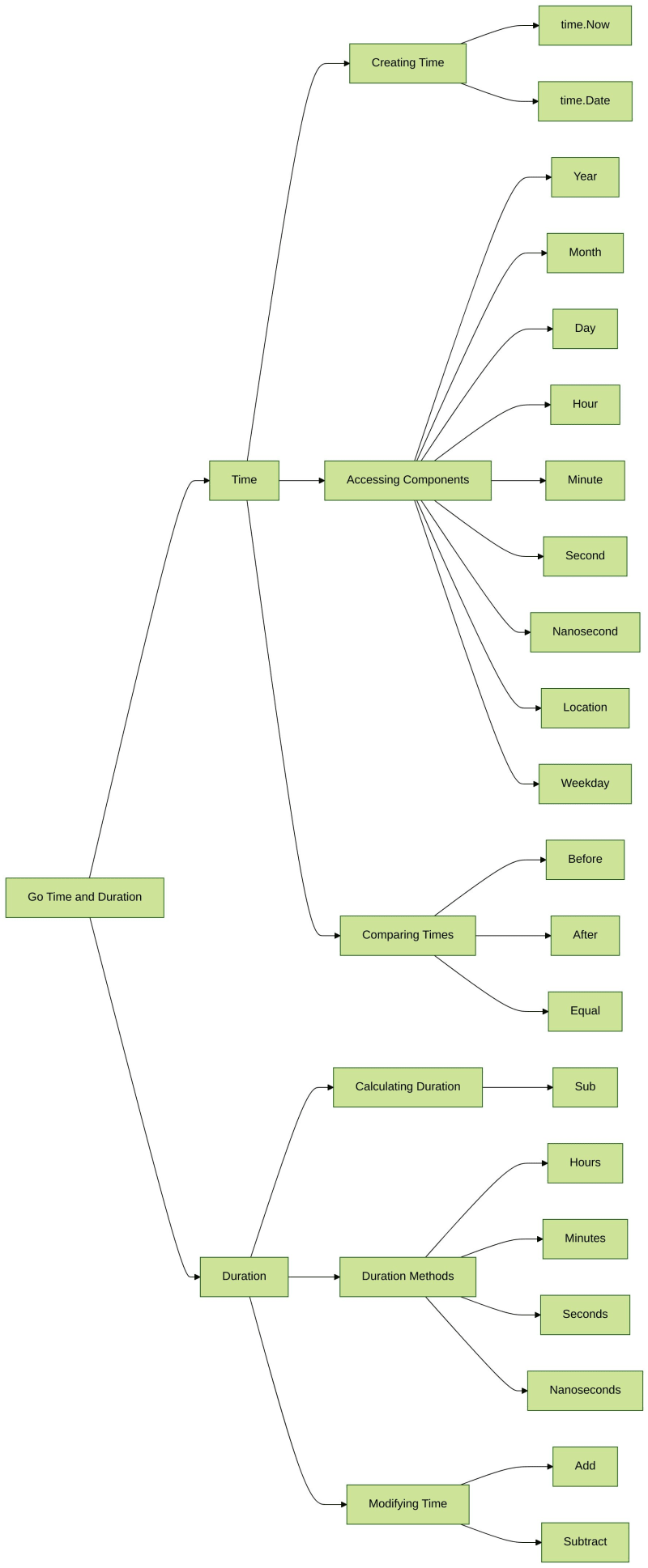移動時間と所要時間 |プログラミングチュートリアル
2024 年 11 月 2 日に公開
導入

このラボは、Go の時間と期間のサポートについての理解をテストすることを目的としています。
時間
以下のコードには、Go で時間と期間を操作する方法の例が含まれています。ただし、コードの一部が欠落しています。あなたの仕事は、コードを完成させて期待通りに動作させることです。
- Go プログラミング言語の基礎知識。
- Go の時間と期間のサポートに精通していること。
$ go run time.go 2012-10-31 15:50:13.793654 0000 UTC 2009-11-17 20:34:58.651387237 0000 UTC 2009 November 17 20 34 58 651387237 UTC Tuesday true false false 25891h15m15.142266763s 25891.25420618521 1.5534752523711128e 06 9.320851514226677e 07 93208515142266763 2012-10-31 15:50:13.793654 0000 UTC 2006-12-05 01:19:43.509120474 0000 UTC # Next we'll look at the related idea of time relative to # the Unix epoch.
以下に完全なコードがあります:
// Go offers extensive support for times and durations;
// here are some examples.
package main
import (
"fmt"
"time"
)
func main() {
p := fmt.Println
// We'll start by getting the current time.
now := time.Now()
p(now)
// You can build a `time` struct by providing the
// year, month, day, etc. Times are always associated
// with a `Location`, i.e. time zone.
then := time.Date(
2009, 11, 17, 20, 34, 58, 651387237, time.UTC)
p(then)
// You can extract the various components of the time
// value as expected.
p(then.Year())
p(then.Month())
p(then.Day())
p(then.Hour())
p(then.Minute())
p(then.Second())
p(then.Nanosecond())
p(then.Location())
// The Monday-Sunday `Weekday` is also available.
p(then.Weekday())
// These methods compare two times, testing if the
// first occurs before, after, or at the same time
// as the second, respectively.
p(then.Before(now))
p(then.After(now))
p(then.Equal(now))
// The `Sub` methods returns a `Duration` representing
// the interval between two times.
diff := now.Sub(then)
p(diff)
// We can compute the length of the duration in
// various units.
p(diff.Hours())
p(diff.Minutes())
p(diff.Seconds())
p(diff.Nanoseconds())
// You can use `Add` to advance a time by a given
// duration, or with a `-` to move backwards by a
// duration.
p(then.Add(diff))
p(then.Add(-diff))
}
まとめ
このラボでは、Go の時間と期間のサポートを使用して作業する能力をテストしました。時間値のさまざまな要素を抽出し、2 つの時間を比較し、継続時間の長さを計算し、指定された継続時間だけ時間を進める方法を学習しました。
?今すぐ練習: 移動時間と継続時間の探索
もっと詳しく知りたいですか?
- ?最新の Go スキル ツリーを学ぶ
- ?続きを読む Go チュートリアル
- ? Discord に参加するか、@WeAreLabEx でツイートしてください
リリースステートメント
この記事は次の場所に転載されています: https://dev.to/labex/go-time-and-duration-programming-tutorials-786?1 侵害がある場合は、[email protected] に連絡して削除してください。
最新のチュートリアル
もっと>
-
 FCS API と Insight Ease: ビットコイン API サービスの簡単な比較ビットコイン API に興味がある場合は、適切な API を選択することが重要です。特に開発者、金融アナリスト、フィンテック企業の経営者であればなおさらです。よく耳にする 2 つの名前は、FCS API と Insight Ease です。しかし、どちらが良いでしょうか?特に暗号通貨ライブ レート...プログラミング 2024 年 11 月 2 日に公開
FCS API と Insight Ease: ビットコイン API サービスの簡単な比較ビットコイン API に興味がある場合は、適切な API を選択することが重要です。特に開発者、金融アナリスト、フィンテック企業の経営者であればなおさらです。よく耳にする 2 つの名前は、FCS API と Insight Ease です。しかし、どちらが良いでしょうか?特に暗号通貨ライブ レート...プログラミング 2024 年 11 月 2 日に公開 -
 HTMLを変更せずにJavaScriptでフォーム送信イベントをリッスンする方法は?HTML を変更せずに JavaScript でフォーム送信イベントをリッスンするこの記事では、HTML を変更せずにフォーム送信イベントをリッスンするという一般的な課題に対処します。 HTMLコードを変更する必要があります。 HTML の onClick 属性や onSubmit 属性に依存する代...プログラミング 2024 年 11 月 2 日に公開
HTMLを変更せずにJavaScriptでフォーム送信イベントをリッスンする方法は?HTML を変更せずに JavaScript でフォーム送信イベントをリッスンするこの記事では、HTML を変更せずにフォーム送信イベントをリッスンするという一般的な課題に対処します。 HTMLコードを変更する必要があります。 HTML の onClick 属性や onSubmit 属性に依存する代...プログラミング 2024 年 11 月 2 日に公開 -
 Document.getElementById と jQuery $(): 主な違いは何ですか?Document.getElementById と jQuery $(): 比較分析Web 開発の領域を掘り下げる場合、バニラ間のニュアンスを理解する必要があります。 JavaScript と jQuery が重要になる場合があります。この記事では、一見同一に見える 2 つのコード スニペット間の微...プログラミング 2024 年 11 月 2 日に公開
Document.getElementById と jQuery $(): 主な違いは何ですか?Document.getElementById と jQuery $(): 比較分析Web 開発の領域を掘り下げる場合、バニラ間のニュアンスを理解する必要があります。 JavaScript と jQuery が重要になる場合があります。この記事では、一見同一に見える 2 つのコード スニペット間の微...プログラミング 2024 年 11 月 2 日に公開 -
 Java でのメソッドおよび変数ハンドルを使用したランタイム オブジェクトのアクセスと操作リフレクションとメソッド/変数ハンドルは、開発者が実行時にオブジェクトにアクセスして操作できるようにする Java の 2 つの強力な機能です。ただし、オブジェクトにアクセスして処理する方法が異なります。 リフレクションを使用してクラス内のメソッドにアクセスする方法の例を見てみましょう。まず、プライ...プログラミング 2024 年 11 月 2 日に公開
Java でのメソッドおよび変数ハンドルを使用したランタイム オブジェクトのアクセスと操作リフレクションとメソッド/変数ハンドルは、開発者が実行時にオブジェクトにアクセスして操作できるようにする Java の 2 つの強力な機能です。ただし、オブジェクトにアクセスして処理する方法が異なります。 リフレクションを使用してクラス内のメソッドにアクセスする方法の例を見てみましょう。まず、プライ...プログラミング 2024 年 11 月 2 日に公開 -
 組み込み関数を使用して Python で IP アドレスを検証する方法Python での IP アドレスの検証IP アドレスの有効性の検証は、プログラミングにおける一般的なタスクです。ユーザーから IP アドレスを文字列として受け取る場合は、IP アドレスが正しい形式と構造に準拠していることを確認するために検証することが重要です。Python で IP アドレスを効率...プログラミング 2024 年 11 月 2 日に公開
組み込み関数を使用して Python で IP アドレスを検証する方法Python での IP アドレスの検証IP アドレスの有効性の検証は、プログラミングにおける一般的なタスクです。ユーザーから IP アドレスを文字列として受け取る場合は、IP アドレスが正しい形式と構造に準拠していることを確認するために検証することが重要です。Python で IP アドレスを効率...プログラミング 2024 年 11 月 2 日に公開 -
 プログラミングの学習について助けが必要ですこんにちは、私はシステム エンジニアリングの学生ですが、コースでプログラミングについてあまり学習していないと感じています。このテーマにとても興味があるので、独学で学びたいと思っています。だからこそ私はこのサイトに来て、プログラミングに詳しい人に助けを求めています。基礎から始めてより専門的なレベルに進...プログラミング 2024 年 11 月 2 日に公開
プログラミングの学習について助けが必要ですこんにちは、私はシステム エンジニアリングの学生ですが、コースでプログラミングについてあまり学習していないと感じています。このテーマにとても興味があるので、独学で学びたいと思っています。だからこそ私はこのサイトに来て、プログラミングに詳しい人に助けを求めています。基礎から始めてより専門的なレベルに進...プログラミング 2024 年 11 月 2 日に公開 -
 DateTime サポートを使用して gorm.Model をプロトコル バッファー定義に統合するにはどうすればよいですか?gorm.Model のプロトコル バッファー定義への統合gorm の gorm.Model フィールドを protobuf 定義に統合する場合、proto3 では日時サポートがないために問題が発生します。この記事では、この問題の解決策について説明します。ProtoBuf フィールド タイプ マッピ...プログラミング 2024 年 11 月 2 日に公開
DateTime サポートを使用して gorm.Model をプロトコル バッファー定義に統合するにはどうすればよいですか?gorm.Model のプロトコル バッファー定義への統合gorm の gorm.Model フィールドを protobuf 定義に統合する場合、proto3 では日時サポートがないために問題が発生します。この記事では、この問題の解決策について説明します。ProtoBuf フィールド タイプ マッピ...プログラミング 2024 年 11 月 2 日に公開 -
 Discord アクティビティのネットワーク リクエストにパッチを適用して、スムーズな CSP コンプライアンスを実現するDiscord を通じて Discord アクティビティを実行すると、コンテンツ セキュリティ ポリシー (CSP)の問題が発生する可能性があります。これらを修正するには、ネットワーク リクエストが Discord プロキシ ルールに従っていることを確認します。 これは手動で行うこともできます.....プログラミング 2024 年 11 月 2 日に公開
Discord アクティビティのネットワーク リクエストにパッチを適用して、スムーズな CSP コンプライアンスを実現するDiscord を通じて Discord アクティビティを実行すると、コンテンツ セキュリティ ポリシー (CSP)の問題が発生する可能性があります。これらを修正するには、ネットワーク リクエストが Discord プロキシ ルールに従っていることを確認します。 これは手動で行うこともできます.....プログラミング 2024 年 11 月 2 日に公開 -
 推奨プロジェクト: コーススケジュールビューデータの削除データベース管理の力を解き放つ LabEx のこのプロジェクトは、データベース内のビューの作成と操作に関する包括的な学習体験を提供します。あなたが新進のデータベース管理者であっても、熟練した開発者であっても、このプロジェクトはスキルを向上させ、データ管理の世界について実践的な洞察を得る貴重な機会を提...プログラミング 2024 年 11 月 2 日に公開
推奨プロジェクト: コーススケジュールビューデータの削除データベース管理の力を解き放つ LabEx のこのプロジェクトは、データベース内のビューの作成と操作に関する包括的な学習体験を提供します。あなたが新進のデータベース管理者であっても、熟練した開発者であっても、このプロジェクトはスキルを向上させ、データ管理の世界について実践的な洞察を得る貴重な機会を提...プログラミング 2024 年 11 月 2 日に公開 -
 ネットワークリクエストのモックが簡単に: Jest と MSW の統合Writing unit tests that involve mocking or stubbing API calls can feel overwhelming—I’ve been there myself. In this article, I’ll guide you through a ...プログラミング 2024 年 11 月 2 日に公開
ネットワークリクエストのモックが簡単に: Jest と MSW の統合Writing unit tests that involve mocking or stubbing API calls can feel overwhelming—I’ve been there myself. In this article, I’ll guide you through a ...プログラミング 2024 年 11 月 2 日に公開 -
 JavaScriptを使用したハッシュマップ導入 ハッシュ テーブルとも呼ばれるハッシュ マップは、連想配列の抽象データ型を実装するデータ構造であり、キーを値にマップできる構造です。 ハッシュ関数を使用してバケットまたはスロットの配列へのインデックスを計算し、そこから目的の値を見つけることができます。 ハッシュ マップ...プログラミング 2024 年 11 月 2 日に公開
JavaScriptを使用したハッシュマップ導入 ハッシュ テーブルとも呼ばれるハッシュ マップは、連想配列の抽象データ型を実装するデータ構造であり、キーを値にマップできる構造です。 ハッシュ関数を使用してバケットまたはスロットの配列へのインデックスを計算し、そこから目的の値を見つけることができます。 ハッシュ マップ...プログラミング 2024 年 11 月 2 日に公開 -
 HTPX の紹介: JavaScript および Node.js 用の軽量で多用途の HTTP クライアント開発者として、ブラウザーで JavaScript を使用して構築する場合でも、サーバー側で Node.js を使用して構築する場合でも、Web アプリケーションには信頼性が高く効率的な HTTP クライアントが必要になることがよくあります。だからこそ、私は HTPX を作成しました。これは、最新の開...プログラミング 2024 年 11 月 2 日に公開
HTPX の紹介: JavaScript および Node.js 用の軽量で多用途の HTTP クライアント開発者として、ブラウザーで JavaScript を使用して構築する場合でも、サーバー側で Node.js を使用して構築する場合でも、Web アプリケーションには信頼性が高く効率的な HTTP クライアントが必要になることがよくあります。だからこそ、私は HTPX を作成しました。これは、最新の開...プログラミング 2024 年 11 月 2 日に公開 -
 自然言語を使用して、LLM で単純な Python GUI を生成します .... 数分以内Thought that building Python GUIs took hours of tedious coding? Welcome to an exciting new era! Not only can tools like Github Copilot help with code ...プログラミング 2024 年 11 月 2 日に公開
自然言語を使用して、LLM で単純な Python GUI を生成します .... 数分以内Thought that building Python GUIs took hours of tedious coding? Welcome to an exciting new era! Not only can tools like Github Copilot help with code ...プログラミング 2024 年 11 月 2 日に公開 -
 開発、おっと、WEBAPP のストーリーDevOps プロフェッショナルとしてデスクトップ Web アプリを開発することは、広大で複雑な海を航海しているような気分になることがあります。テクノロジーが融合するにつれて、Web、デスクトップ、クラウドベースのアプリケーション間の境界線が曖昧になり、DevOps は従来フロントが担っていた領域に...プログラミング 2024 年 11 月 2 日に公開
開発、おっと、WEBAPP のストーリーDevOps プロフェッショナルとしてデスクトップ Web アプリを開発することは、広大で複雑な海を航海しているような気分になることがあります。テクノロジーが融合するにつれて、Web、デスクトップ、クラウドベースのアプリケーション間の境界線が曖昧になり、DevOps は従来フロントが担っていた領域に...プログラミング 2024 年 11 月 2 日に公開 -
 Django の可能性を解き放つ: 4 人向けのプロジェクトのアイデアとリソースDjango ニュースレター - 2024 年 10 月 Django の概要とプロジェクトのアイデア Django を始めたい、またはスキルを向上させたいと考えている場合は、考慮すべき貴重なリソースとプロジェクトのアイデアをいくつか紹介します。 D...プログラミング 2024 年 11 月 2 日に公開
Django の可能性を解き放つ: 4 人向けのプロジェクトのアイデアとリソースDjango ニュースレター - 2024 年 10 月 Django の概要とプロジェクトのアイデア Django を始めたい、またはスキルを向上させたいと考えている場合は、考慮すべき貴重なリソースとプロジェクトのアイデアをいくつか紹介します。 D...プログラミング 2024 年 11 月 2 日に公開
中国語を勉強する
- 1 「歩く」は中国語で何と言いますか? 走路 中国語の発音、走路 中国語学習
- 2 「飛行機に乗る」は中国語で何と言いますか? 坐飞机 中国語の発音、坐飞机 中国語学習
- 3 「電車に乗る」は中国語で何と言いますか? 坐火车 中国語の発音、坐火车 中国語学習
- 4 「バスに乗る」は中国語で何と言いますか? 坐车 中国語の発音、坐车 中国語学習
- 5 中国語でドライブは何と言うでしょう? 开车 中国語の発音、开车 中国語学習
- 6 水泳は中国語で何と言うでしょう? 游泳 中国語の発音、游泳 中国語学習
- 7 中国語で自転車に乗るってなんて言うの? 骑自行车 中国語の発音、骑自行车 中国語学習
- 8 中国語で挨拶はなんて言うの? 你好中国語の発音、你好中国語学習
- 9 中国語でありがとうってなんて言うの? 谢谢中国語の発音、谢谢中国語学習
- 10 How to say goodbye in Chinese? 再见Chinese pronunciation, 再见Chinese learning

























